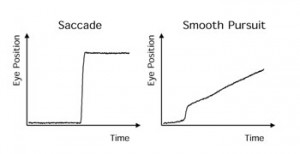As is well known, high resolution vision in humans is only limited to a small area of the visual field. Despite this fact, humans have the perception of a vivid, clear scene throughout the visual field, and this is due to the fact that humans are active observers. By moving their eyes around, humans effectively compensate for the resolution limitations that are inherent in their retinae.

There are two main classes of voluntary eye movements that are employed by humans: saccades, which are rapid changes in eye position that align gaze on peripheral objects, and smooth pursuit eye movements, which are smooth movements that stabilize the image of a moving object on the retina. Associated with every voluntary eye movement are various sensory and motor processes that not only ensure that the eye lands on its intended target, but that also serve higher-level perceptual and cognitive processes. We are interested in learning about these processes in more detail.
See our ACTION FOR PERCEPTION demo page, as well as our results on LOOKING AT VISUAL OBJECTS
We also explore the use of eye movements by blind patients who have received a retinal implant to partially restore their vision. The demo movie HERE demonstrates the importance of eye movements for visual perception.
